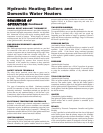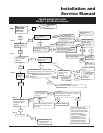
Installation and
Service Manual
61
are energized. This does not interfere with the safety functionality
of either pressure switch or the ignition modules.
IGNITION
(Ignition Module Function)
Once the trial for ignition period has been completed, the ignition
module sends 24VAC to the gas valves on one or the other of the
primary stages . Gas valves should open and allow gas to flow to
the burners in the stages being energized. The fuel/air mixture
should ignite from the hot surface igniter. Once this voltage has
been sent to the valves, the hot surface igniter is turned off. The
ignition module then monitors the status of the flame and will
either allow ignition to continue or shut down the gas valves
should flame not be proven and proceed to a Flame Failure
condition. If flame was proven briefly during the ignition period,
the module may not proceed to Flame Failure, but rather post-
purge and then go into another trial for ignition.
HEAT TRANSFER PROCESS
(Gas Valves, Burner and Heat Exchanger)
Once flame has been proven, the ignition module will hold the gas
valves open as long as there is proof of flame and a call for heat is
present. Depending upon the number of stages being called upon
by the electronic thermostat controller, more or less B.T.U.’s are
delivered to the water within the heat exchanger. Once the
temperature rise is sufficient to allow stages to be turned off, the
electronic thermostat will begin to shut down stages in
preprogrammed order to prevent the set point from being
exceeded. When the temperature of the water reaches that of the
highest programmed set point, all stages will be shut down.
POST-PURGE
(Ignition Module Function) When 24VAC is removed from the
ignition module’s thermostat input, the module turns off the gas
valves and maintains the blowers for approximately 25 seconds in
order to allow the combustion chamber to be purged of all
combustion by-products.
IDLE
(Electronic Thermostat Function)
After completion of the post-purge cycle, the unit will go into an
idle state whereby the electronic thermostat continuously
monitors the water temperature until the water temperature drops
to levels that require additional heat.


















